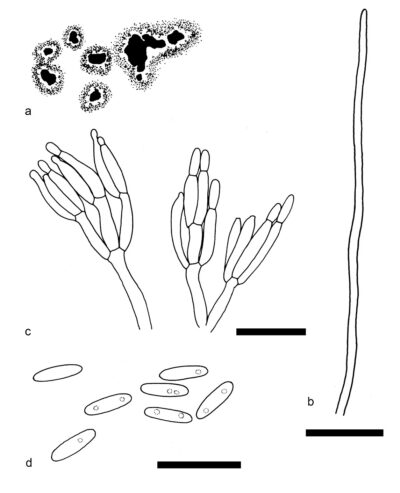Fungalpedia – Note 319, Neomyrothecium
Neomyrothecium L. Lombard & Crous
Citation when using this entry: Perera et al. 2024 (in prep) – Fungalpedia, genera described in 2016.
Index Fungorum, Facesoffungi, MycoBank, GenBank, Fig. 1
Classification: Stachybotryaceae, Hypocreales, Hypocreomycetidae, Sordariomycetes, Pezizomycotina, Ascomycota, Fungi
Based on phylogenetic analyses of concatenated cmdA, ITS, rpb2, and tub2 loci, Lombard et al. (2016) proposed that Neomyrothecium accommodates a single lineage, N. humicola. Neomyrothecium humicola shares similar morphological characteristics with Paramyrothecium species but is phylogenetically distinct (Lombard et al. 2016). Neomyrothecium is a hyphomycete genus characterized by sporodochial conidiomata that are stromatic, superficial, scattered, and gregarious. Sporodochia are pulvinate, oval or irregular in shape and covered by olivaceous green to dark green slimy masses of conidia. However, they lacked white setose fringes. The stroma is weakly developed, hyaline, and consists of the textura angularis. The setae are sparse, unbranched, straight to flexuous, septate, hyaline, thin-walled, and tapered to an acute apex. The Neomyrothecium produces macronematous and penicillately branched conidiophores with smooth walls. They give rise to phialidic conidiogenous cells that are cylindrical to sub-cylindrical, straight to slightly curved, hyaline, and smooth-walled. Phialides show visible collarette and periclinal thickening. Conidia are aseptate, hyaline, and cylindrical with rounded ends. This sexual morph has not yet been reported (Lombard et al. 2016). Neomyrothecium humicola has previously been isolated from coastal soils (Lombard et al. 2016).
Type species: Neomyrothecium humicola L. Lombard & Crous
Other accepted species: This genus is monotypic.
Figure 1 – Neomyrothecium humicola (CBS 310.96, ex-type). a Sporodochial conidiomata on SNA. b Seta. c Conidiogenous cells. d Conidia. Scale bars: b = 20 μm, c, d = 10 μm. Redrawn from Lombard et al. (2016)
Reference
Entry by
Rekhani Hansika Perera, Center of Excellence in Fungal Research, Mae Fah Luang University, Chiang Rai, 57100, Thailand.
(Edited by Kevin D. Hyde, Samaneh Chaharmiri-Dokhaharani, & Achala R. Rathnayaka)
Published online 27 August 2024
